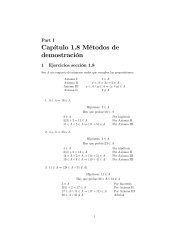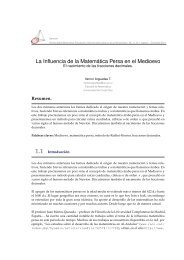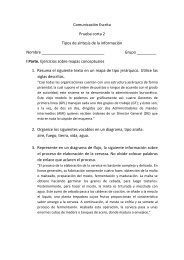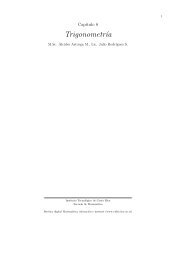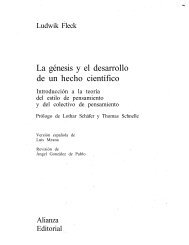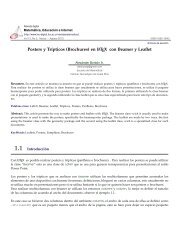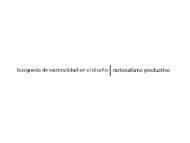Derivada de una función - TEC-Digital
Derivada de una función - TEC-Digital
Derivada de una función - TEC-Digital
You also want an ePaper? Increase the reach of your titles
YUMPU automatically turns print PDFs into web optimized ePapers that Google loves.
Diferenciales 27<br />
Pue<strong>de</strong> <strong>de</strong>cirse que h es la diferencia entre las abscisas <strong>de</strong> dos puntos <strong>de</strong> la gráfica <strong>de</strong> f. Esta diferencia recibe<br />
el nombre <strong>de</strong> incremento <strong>de</strong> x y se <strong>de</strong>nota por △x.<br />
Para <strong>una</strong> <strong>función</strong> f , dada al sustituir h por △x en la expresión<br />
<strong>de</strong> don<strong>de</strong> f ′ (x) = lim<br />
△x→0<br />
f(x + △x) − f(x)<br />
.<br />
△x<br />
f(x + h) − f(x)<br />
h<br />
, se obtiene<br />
f(x + △x) − f(x)<br />
△x<br />
Si y = f(x) entonces el incremento en “y” correspondiente al incremento △x <strong>de</strong> x, que se <strong>de</strong>nota por △y, está<br />
dado por f(x + △x) − f(x).<br />
Así , △y es el cambio en “y” <strong>de</strong>bido al cambio △x en x.<br />
La razón △y f(x + △x) − f(x)<br />
= recibe el nombre <strong>de</strong> razón promedio <strong>de</strong> cambio <strong>de</strong> f o <strong>de</strong> “y”, respecto a x,<br />
△x △x<br />
para el intervalo [x, x + △x].<br />
△y<br />
La <strong>de</strong>rivada: Dxy = lim<br />
△x→0 △x<br />
f(x + △x) − f(x)<br />
= lim<br />
△x→0 △x<br />
simplemente razón <strong>de</strong> cambio <strong>de</strong> “y” o <strong>de</strong> f respecto a x.<br />
Ejemplo 1<br />
1. Si y = 2x 2 + 1 hallar △y en términos <strong>de</strong> x y △x.<br />
i. Determinar △y para:<br />
a. x = 1, △x = 0.1<br />
b. x = 10, △x = 0.01<br />
Solución:<br />
△y = f(x + △x − f(x))<br />
= 2(x + △x) 2 + 1 − (2x 2 + 1)<br />
= 2(x 2 + 2x △ x + (△x) 2 ) + 1 − 2x 2 − 1<br />
= 2x 2 + 4x △ x + 2(△x) 2 − 2x 2<br />
= (4x + 2 △ x) △ x<br />
a. Para x = 1, △x = 0.1 se tiene que:<br />
△y = (4 · 1 + 2 · 0.1)0.1 = 0.42<br />
recibe el nombre <strong>de</strong> razón instantánea <strong>de</strong> cambio o<br />
Pue<strong>de</strong> <strong>de</strong>cirse que existe un incremento <strong>de</strong> 0.42 en las or<strong>de</strong>nadas <strong>de</strong>bido a un incremento <strong>de</strong> 0.1<br />
en las abscisas.<br />
b. Para x = 10 y x = 0.01 se tiene que:<br />
△y = (4 · 10 + 2 · 0.01)0.01 = 4.002




